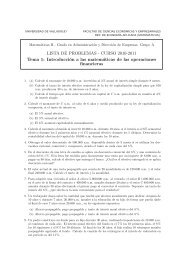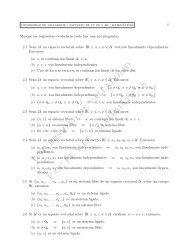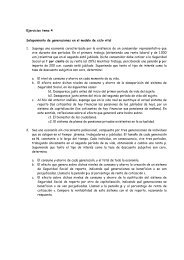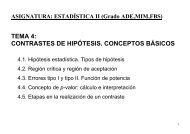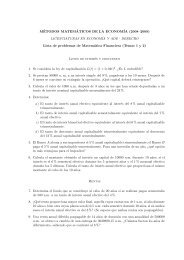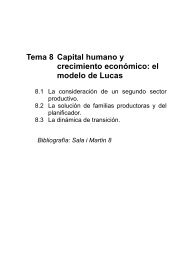A DISTANCE-BASED EXTENSION OF THE MAJORITY ...
A DISTANCE-BASED EXTENSION OF THE MAJORITY ...
A DISTANCE-BASED EXTENSION OF THE MAJORITY ...
Create successful ePaper yourself
Turn your PDF publications into a flip-book with our unique Google optimized e-Paper software.
8 EDURNE FALCÓ AND JOSÉ LUIS GARCÍA-LAPRESTA<br />
Table 4. Assessments in Example 2<br />
x 1 l 1 l 2 l 4 l 4 l 4 l 6<br />
x 2 l 1 l 1 l 3 l 4 l 6 l 6<br />
x 3 l 2 l 2 l 2 l 4 l 5 l 6<br />
x 4 l 1 l 1 l 4 l 5 l 5 l 5<br />
tie-breaking process, we have t(x 1 ) = −1 < 1 = t(x 4 ). Thus, MJ produces the outcome<br />
x 4 ≻ x 1 ≻ x 2 ≻ x 3 . We now consider the distance-based procedure for seven<br />
values of p. In Table 5 we can see the influence of these values on (l(x j ), D(x j )), for<br />
j = 1, 2, 3. The corresponding rankings are included in Table 6. For p = 1, we have<br />
Table 5. (l(x j ), D(x j )) in Example 2<br />
p = 1 p = 1.25 p = 1.5 p = 1.75 p = 2 p = 5 p = 10<br />
x 1 (l 4 , −3) (l 4 , −2.375) (l 4 , −2.008) (l 4 , −1.770) (l 3 , 1.228) (l 3 , 0.995) (l 3 , 0.000)<br />
x 2 (l 3 , 10) (l 3 , 2.264) (l 3 , 1.888) (l 3 , 1.669) (l 3 , 1.530) (l 3 , 1.150) (l 3 , 1.072)<br />
x 3 (l 2 , 9) (l 3 , 2.511) (l 3 , 2.254) (l 3 , 2.104) (l 3 , 2.010) (l 4 , −0.479) (l 4 , −0.232)<br />
x 4 (l 4 , −3) (l 4 , −2.815) (l 4 , −2.682) (l 4 , −2.585) (l 3 , 0.777) (l 3 , 0.199) (l 3 , 0.089)<br />
Table 6. Rankings in Example 2<br />
MJ p = 1 p = 1.25 p = 1.5 p = 1.75 p = 2 p = 5 p = 10<br />
x 4 x 1 x 1 x 1 x 1 x 3 x 3 x 3<br />
x 1 x 4 x 4 x 4 x 4 x 2 x 2 x 2<br />
x 2 x 2 x 3 x 3 x 3 x 1 x 1 x 1<br />
x 3 x 3 x 2 x 2 x 2 x 4 x 4 x 4<br />
T (x 1 ) = (l 4 , −3, 7), T (x 2 ) = (l 3 , 10, 11), T (x 3 ) = (l 2 , 9, 9) and T (x 4 ) = (l 4 , −3, 9).<br />
Then, we obtain the ranking x 1 ≻ x 4 ≻ x 2 ≻ x 3 , a different outcome than obtained<br />
using MJ. For p = 1.25, p = 1.5 and p = 1.75, we obtain x 1 ≻ x 4 ≻ x 3 ≻ x 2 ; and<br />
for p = 2, p = 5 and p = 10, we have x 3 ≻ x 2 ≻ x 1 ≻ x 4 .<br />
Example 3. Similarly to the previous example, Table 7 includes the assessments<br />
given by seven voters to three alternatives x 1 , x 2 and x 3 arranged from the lowest<br />
to the highest labels. Clearly, the individual assessments of the three alternatives<br />
Table 7. Assessments in Example 3<br />
x 1 l 1 l 1 l 2 l 3 l 6 l 6 l 6<br />
x 2 l 2 l 3 l 3 l 3 l 6 l 6 l 6<br />
x 3 l 3 l 3 l 3 l 3 l 4 l 4 l 4<br />
share the same median, l 3 . According to the MJ tie-breaking process, we have<br />
t(x 1 ) = 0 < 1 = t(x 2 ) = t(x 3 )<br />
N + (x 1 ) = N + (x 2 ) = N + (x 3 ) = 3<br />
N − (x 3 ) = 0 < 1 = N − (x 2 ) < 3 = N − (x 1 ).



